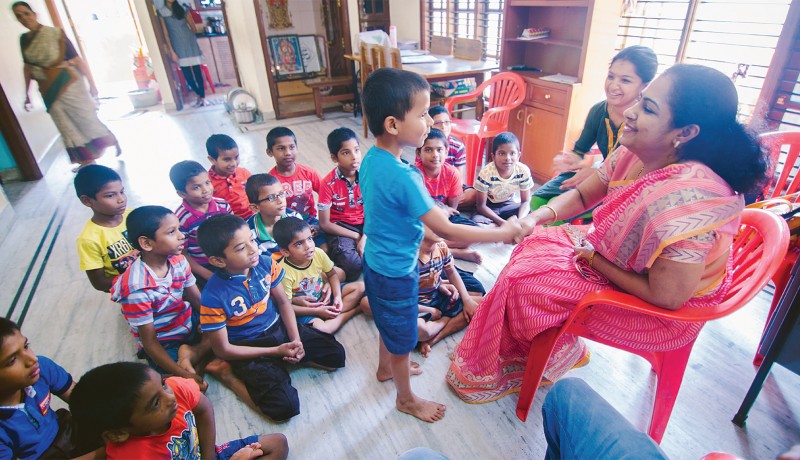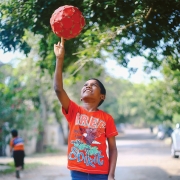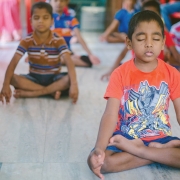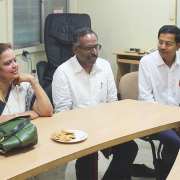
People

Over 25 years ago, a group of professionals took an oath to repay their debt to society by opening doors for underprivileged boys. Chitra Ramaswamy discovers some amazing success stories.
Venkatesh oozes confidence as he alights from his bike and shakes off his helmet. The 25 year-old former Infosys employee is a budding entrepreneur and his Bengaluru-based web design company is going great guns with franchises overseas. Yogesh, who completed his post-graduation in biochemistry, is pursuing a full-scholarship PhD in clean energy from Carnegie Mellon University in the US. Ramesh, an artist and sportsperson, who routinely participates and wins various marathons across the country, is a brand ambassador for an international sporting goods company.
While these achievements may seem ordinary, there is one fundamental difference: these young men started with a handicap that could have scripted a very different fate for each one of them. But thanks to Bengaluru-based Snehalaya Homes, they, and many others like them, are part of the mainstream and live each day with a smile.
“I was one of the first kids to be admitted to Snehalaya, when I was just four years old; that was 26 years ago,” says Raghavendra, an associate consultant with Mindtree in Bengaluru. “I got the best of everything—an education, house mothers, a big family with whom I share a strong bond and, above all, a strong value system.”
Indeed, Snehalaya is more than just a residential facility for destitute boys. It was set up in 1991 under MILT or the McGrath Institute of Leadership Training Charitable Trust, by internationally acclaimed management guru and trainer Aporesh Acharya, former faculty at Dale Carnegie Associates in the US.
“Setting up Snehalaya Homes was a decision taken by a group of Miltonians, who hail from all walks of life. We had all undergone a powerful leadership training programme under the legendary Aporesh Acharya,” explains 71 year-old R Venkatanathan, vice-president of Karvy Group, and a founder member. “The urge to rise above selfish commercial interests and give back to society was the compelling and inspirational learning experience from Acharya’s programme.”
C Grahadurai, 53, chairperson of the MILT Central Trust and the two Bengaluru chapters of Snehalaya, adds, “We believe we all have a responsibility towards society and by giving back to it, we are only purifying ourselves, and that the taker is actually obliging us in this self-purification process.”
The first two Snehalaya centres were established in Bengaluru’s Malleswaram and Banashankari residential areas; a few months later, a centre each was opened in Chennai, Kolkata and Mumbai.
What distinguishes these institutions from others that care for disadvantaged boys is its focus on shaping their young wards into future achievers and leaders. They call it ‘growth-oriented development’. Thus, with the help of social workers, Snehalaya handpicks only 15 boys—either orphans or those who have only one parent—for each of the five centres, every year.
While living at the facility, these boys are schooled in the mainstream till Class 5. After that, they continue their education at the MILT Residential School in Shimultala, Bihar, where informal education is the mode of study. Here, the emphasis is on leadership training even as the boys are put through a regimen that is a mix of academics and sports. Eventually, they take the Class 10 and 12 board examinations under the Central Government’s National Institute of Open Schooling system.
From Classes 9 to 12, the boys undergo leadership training programmes under Aporesh Acharya himself, as the objective is to provide value-based education to turn them into successful young achievers. Depending on their aptitude, they are guided and sponsored by Miltonians to pursue higher education, take up jobs or set up their own enterprises.
We are at the Snehalaya Home in Banashankari, Bengaluru. On the porch of the double-storey yellow building, 15 pairs of sports shoes are lined up neatly. The place is abuzz with chatter and laughter. The camaraderie among the boys is touching as they troop in after school, their schoolbags stacked neatly in a row under a long study table. The children then wash their hands and feet and get ready for evening tea. They follow a strict routine, which teaches them discipline and fosters a sense of independence.
Seetha Holla, an administrator at the home, has been working here with her husband since the institution opened in 1991. Although the couple have their own business, they are unable to tear themselves away from the Snehalaya family. “When I first became aware of Snehalaya and the selfless service rendered by the Miltonians, I was struck by their commitment,” says the 53 year-old. “The urge to join the institution was compelling. Being part of this trust and interacting with the children, I feel enriched. To see them happy and successful is very rewarding.”
When Snehalaya was launched, it was not all smooth sailing though. “Our first roadblock was sourcing the children in the initial years! While there are teeming millions in need, we needed to establish the authenticity of each case. A few years down the line, we appointed a qualified social worker to scour the slums and network with other NGOs, and the state government’s Women & Child Welfare Department, to bring deserving children to us,” shares Venkatanathan about the trust’s very focused approach.
“We verify the authenticity of their circumstances and the boys undergo a thorough medical check-up before we take them in,” says 60 year-old Kusum Gopinath, an administrator at the Malleswaram chapter. Quality, rather than quantity, is the watchword of the Miltonians. “Although we admit children up to the age of five, we prefer taking them in when they are as young as two or three years old. It is easier to groom them, mould their behaviour and personality, and instil value systems in them at this tender age.”
Initially, getting the children admission in private schools was a tall task as institutions were reluctant to admit children of their background. “But, over and over again, our boys proved themselves by winning prizes and medals in competitions in various fields and schools now open their doors to us,” says Grahadurai.
As the children come from disadvantaged backgrounds, behavioural issues are often prevalent. “Sometimes, we do come across errant behaviour and when the behaviour pattern is beyond the scope of counsellors, we send these children back to their biological parents or rehabilitate them in orphanages or other NGOs,” reveals Gopinath of the Malleswaram home.
“There have been one or two stray cases when parents have pulled their child out of Snehalaya,” adds Gopinath. “We invest a significant sum of money in nurturing each boy and, when this happens, our efforts go to waste once the child returns to the slums. This has also a negative impact on the other children at the centre.”
Parents are therefore discouraged from visiting their children too often and are allowed a visit once every 45 days. The children are also not sent home during vacations or festivals. “Instead, we members take these children to our homes for three or four days during vacation time and they interact with our own children,” says Venkatanathan. “We take them to the movies, on picnics, and keep them engaged in camps during the long summer and other breaks.”
“At the time of admission to Snehalaya, we clearly spell out our terms to the parents,” explains Gopinath. “By the time these children reach Class 5, the parents become aware of our purpose and recognise how much their child stands to gain being with us. So they are only too willing to have them continue with us through to Class 12, even if it means having their child study far from home.”
It is this careful grooming that makes each of their wards a winner. Take 30 year-old Balakrishna, for instance. It’s been a long journey from being the son of domestic help to working with Australian Bank in Bengaluru. After graduating from MILT Residential School in Shimultala, Balakrishna enrolled for a BCom degree in Bengaluru, with the help of Snehalaya.
“Snehalaya gave me everything an orphan craves for—selfless love, motherly affection, an education and a way to lead life. Above all, they taught me to be a good citizen and an asset to my country,” says Balkrishna, whose mother passed away when he was in Class 8.
Manjunath L S, 33, has an equally poignant story. Before coming to Snehalaya, he lived with his grandmother in Bengaluru’s Majestic locality, where she used to sell milk. Although she was uneducated, the lady was very keen that her grandson get an education and thus handed him over to the care of Snehalaya. Today, Manjunath has a BE degree in electronics and communication as well as an MS degree in embedded systems design; he works with engineering multinational Robert Bosch. “My present station in life is owing to the values I imbibed in Snehalaya. It is my first home,” says Manjunath, who is now married and living in Germany.
The lives of these young men began in circumstances that social workers like Jhansi are all too familiar with. A field activist with Bosco Mane, a Bengaluru-based NGO that partners with another NGO called Young At Risk, Jhansi has been associated with Snehalaya for four years.
“From time to time, we identify very poor children from the slums and send them to Snehalaya Homes,” she says. “Snehalaya does not believe in numbers, and when we send children there, we are sure they will get the best of everything as they are very strict about entry norms and believe in quality. We know the boys’ future is secure.”
Asha Narasimhan, joint secretary of Socare Ind, an NGO dedicated to the children of life convicts in Bengaluru, is closely associated with Snehalaya through her work. “Our children look forward to the annual visit to Snehalaya Homes on the occasion of the trust’s birthday. Many of our children and some of their children study in the same school, East West School, in Rajaji Nagar. On one hand, they are curious to learn about each others’ circumstances and, on the other, they feel they are not living in isolation as there are other kids like them, being given a great chance in life, of being groomed well and enjoying life as any normal middle class child would do,” she elaborates.
For his part, Bengaluru-based K L Sudheer met his share of slum and street children nabbed for various undesirable activities during his career as inspector-general of police. Himself a Miltonian, Sudheer commends Snehalaya’s effort in saving at least some children and offering them a shot at a great future. “I have watched Snehalaya grow in the past eight to 10 years,” he says. “These children, who may have become vagabonds and a drain on society, are now productive citizens with a well-grounded value system. They have been nurtured not only with a good education but abundant love and the warmth of a home.”
Photos: Sumukh Bharadwaj Featured in Harmony — Celebrate Age Magazine February 2017
you may also like to read
-
For the love of Sanskrit
During her 60s, if you had told Sushila A that she would be securing a doctorate in Sanskrit in the….
-
Style sensation
Meet Instagram star Moon Lin Cocking a snook at ageism, this nonagenarian Taiwanese woman is slaying street fashion like….
-
Beauty and her beast
Meet Instagram star Linda Rodin Most beauty and style influencers on Instagram hope to launch their beauty line someday…..
-
Cooking up a storm!
Meet Instagram star Shanthi Ramachandran In today’s web-fuelled world, you can now get recipes for your favourite dishes at….











